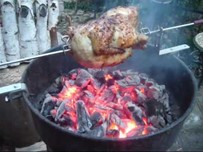1. Semantic meanings of 焦 (jiao)
The following meanings can be extracted from the form of 焦 (jiao – burner):
– 焦 is the sum of the meanings between 隹 (zhui – short-tailed bird) and 灬 (huo – fire). Visually, it shows the bird being fried over the fire.
– Currently, 焦 (jiao) is also used for joule, a unit of energy measurement in the international system of units. Choosing 焦 (jiao) as the equivalent of joule is not accidental, as the image of the character shows the transfer of energy from the burning twigs or coals to the short-tailed bird.
– The meaning of burner, which is the internationally used translation, is also one of the meanings of this character in Chinese. The question arises as to whether the word burner has the meaning of source (the place where twigs are ignited) or target (the bird). In the latter case, it means that the source is external and the triple burner indicates the place towards which certain energies converge.
2. Medical controversy
There is no consensus on the meaning of 焦 (jiao) in Chinese:
– Some say that 焦 (jiao) is 膲 (jiao), which is an obviously newer form. Those who adhere to this opinion fall into two groups:
a. one group thinks that 月 together with 焦 clearly show that sanjiao are organs which have form;
b. another group uses 膲 (jiao) with the meaning found in the dictionary of 康熙 (Kang Xi), namely that of formless fu organ (无形之府). Those who adhere to this meaning compare sanjiao to a flame, for which no form can be established, as it is formless qi ( 无形之气 ).
– Other opinions state that 焦 (jiao) is 樵 (qiao), i.e. twigs, kindling, firewood. Moreover, 樵 (qiao) also means a stick that is used for drumming, namely an object that helps to emit sounds (sound energy). This shows that those who share this point of view interpret jiao as a wood-like organ, which is used to emit various energies – sound, heat, etc. Those who adhere to this view believe that the triple jiao represents three areas: an upper area, a middle area, and a lower area.
– There are also opinions according to which the triple burner is only a concept that delimits certain areas of the body.
Note: One can see that, to those holding the first opinions, burner means the target (the bird) where energies gather; for the second category of opinions, the burner is the flame, hence a form of energy between the source and the target; and for the third category of opinions, the burner is the source (the wood).
Our opinion is that 焦 has the meaning of burner existing in the colloquial language, i.e. the place where fire is lit. The place from where energy is generated and propagated. Probably the electron model described by Bohr applies here as well, and the leap from one energy level to another is made from the bottom up.
3. Location of the triple burner
The triple burner is the empty space that separates the five zang organs and the six fu organs from the rest of the body; depending on the spatial position, the triple burner is divided into:
- the upper burner (上焦 shang jiao) – which includes the area above the diaphragm, i.e. the heart and the lungs;
- the middle burner (中焦 zhong jiao) – which includes the area between the diaphragm and the umbilicus, i.e. the spleen, the liver, the stomach, and the gallbladder;
- the lower burner (下焦 xia jiao) – which includes the area below the umbilicus, i.e. the kidneys, the urinary bladder, the large intestine, and the small intestine.

4. Reasons for including the triple burner into the fu organs category
- In a broad sense, the triple burner encloses the zang organs and separates the chest cavity from the abdominal cavity; since the triple burner is viewed as an empty space, it is similar to the image of the stomach and the other fu organs which, in the absence of contents, also form empty (hollow) spaces. This is the reason why the triple burner is included into the category of fu organs.
- Since the triple burner cannot be paired with the other organs, it is called 孤府 (gufu) – orphan (solitary) fu organ.
- Given its spatial position (it encloses the zang organs), the triple burner is also called 外腑 (waifu) – external fu organ.
5. Functions of the triple burner:
Common functions of the triple burner:
– it transmits the primordial qi ( 元气 ), which is the initial source of motion and life throughout the body; the roots of the primordial qi are in the kidneys;
– it is the pathway for the cyclical flow of qi (it contains the places where qi starts and ends);
– it is the pathway for the flow of fluids.
Particular functions of the triple burner:
In the second volume (chapter 801) of The Inner Canon of the Yellow Emperor, it is stated that:
– 上焦如雾 (the upper burner [is] like fog) – this comparison is intended to show that the upper burner spreads the qi of the lungs and blood throughout the body;
– 中焦如沤 (the middle burner [is] like water bubbles) – this comparison is meant to show the transformation and disintegration that take place in the stomach and spleen;
– 下焦如渎 下焦如渎 (the lower burner [is] like a sewer) – this comparison shows communication with the outside.
1《灵枢。营卫生会》上焦如雾,中焦如沤 ,下焦如渎
Note: The triple burner forms no relation such as yin within yang, yang within yang, yang within yin etc.


